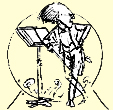
|
|
Title
|
| |
None |
|
Date |
| |
Undated [13–29 June 1894] |
|
Calligraphy |
| |
Black ink, with pencil deletion |
|
Paper |
| |
Unruled, no maker's
mark, upright format, 345 x 210 |
|
Manuscript structure and collation |
| |
2 fol.: |
|
|
[1r] = draft text for the finale, six stanzas |
|
|
[1v–2r] = blank |
|
|
[2v] = inscription from Fritz Löhr to Bruno Walter:
|
Bruno Walter / übergab ich dies alte,
zur Zeit / der Entstehung des Werkes für / mich
beschriebene Blatt / in tiefer herzlicher
Dankbarkeit / aus meinem Besitz / zu Neujahr 1912 /
Friedrich Löhr |
To Bruno Walter I present this old sheet from my
collection, written out for me at the time of the creation of
the work, with deeply heart-felt thanks, at New Year 1912,
Friedrich Löhr. |
|
|
Provenance |
| |
Ex coll. Fritz Löhr, who presented the draft to Bruno Walter on
1 January 1912. Offered for sale at by J.A. Stargardt on 23/24
November 1971, lot 721. |
|
Facsimiles |
| |
Complete colour facsimile:
US-NYp [1r]:
GMS2Fac, 49;
GKMRC, 24;
NKGII.2, 194 |
|
Select Bibliography |
| |
HLG1F, 1027–29;
GMS2Fac, 62;
GKMRC;
NKGII.2, [189]–195 |
|
Notes |
| |
The dating of this draft
relative to
AL2
is uncertain and contrary views have been taken by Edward R.
Reilly (ERBH,
62) and, apparently, the editors
of
NKGII. Reilly believed that AL3
to be the earlier of the two documents, chiefly
because of the absence of the crucial lines:
O
Schmerz! Du Alldurchdringer!
Dir bin ich entrungen!
O
Tod, du Allbezwinger!
Nun bist du bezwungen!
These are present in
AL2
and the text as set, so their omission is perplexing if AL3
post-dates
AL2. In a footnote (ERBH,
61, fn. 14), Reilly also suggested that 'it is most interesting
that a thematic link that one finds between the song and the
finale in just that passage that was added by Mahler to his text
[i.e. in
AL2]', which, were it the case, might
also offer
some slight support for J.B. Foerster's report that the decision
to include Urlicht in the Symphony was a late one, made
only after the work's finale had been completed. But one might
respond that the reference to the music of Urlicht
(b.660ff) is a setting
not of the four 'missing' lines absent from AF3,
but text that is present, albeit in variant forms, in both
AL2 and AL3:
[Mit
Flügeln, die ich mir errungen]
In
heissem Liebesstreben
werd' ich
entschweben
zum
Licht, zu dem kein Aug' gedrungen!
On the wider issue of the chronological ordering of the libretto
drafts, some observations can be offered in support of
the alternative ordering of the drafts adopted here and in
NKGII:
•
AL2 retains a closer connection with the Mahler's original source of
inspiration, by ending with a return to the opening stanza by
Klopstock; AL3 drops this idea and instead
uses stanza VI of
AL2 as the
concluding text, the solution adopted in the text as set.
• The assignment in AL3 of the third
stanza to the alto (rather than the soprano, as in
AL2) was adopted in the final setting.
• AL3 adopts revisions made in
AL2
(e.g. stanza IV, line 2)
•
S5.6
adopts revisions made in AL3
(e.g. stanza III, line 2)
None of these observations is decisive, and because of the
unavailability of most of Mahler's composition draft [SS5] and
the entire orchestral draft [OD5] the issue of the chronology of these text drafts
cannot be finally resolved.
|
| |
|
|



